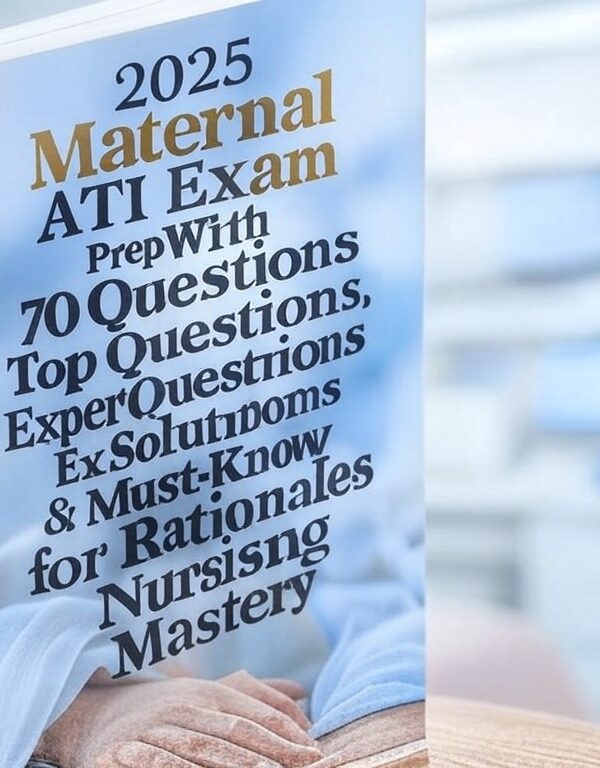The ATI Proctored Exam – Maternal Newborn 2025: Comprehensive Study Guide is an essential resource crafted for nursing students preparing for the ATI Maternal Newborn Proctored Exam. This in-depth guide includes 100 expertly designed practice questions with detailed answers to solidify understanding of critical maternal and newborn nursing topics. It covers key areas such as prenatal care, labor and delivery, postpartum care, newborn assessment, and high-risk pregnancy management, while incorporating the latest 2025 exam updates, including Next Generation NCLEX (NGN) question formats like clinical judgment scenarios and select-all-that-apply questions. With a focus on evidence-based practice, this study guide provides strategies to enhance critical thinking, improve test-taking skills, and address complex maternal-newborn scenarios with confidence. Perfect for RN and PN students, this resource ensures thorough preparation for the ATI Proctored Exam, helping learners achieve a passing score and excel in maternal-newborn nursing.
Preview
A nurse in an antepartum clinic is caring for a client who is at 24 weeks gestation. Which of
the following findings should the nurse report to the provider?
Show Explanation – – correct ans- -Correct Answer:
Frequent headaches
The nurse should report frequent headaches to the provider. Frequent headaches, swelling
of the face and fingers, visual disturbances, and epigastric pain are associated with
preeclampsia.
Incorrect Answers:
B. Leukorrhea is a common discomfort of pregnancy and is an abundant amount of vaginal
mucus that may occur throughout pregnancy.
C. Epistaxis is a common discomfort of pregnancy related to the increase of estrogen.
D. Periodic numbness of the fingers is a common discomfort of pregnancy due to
compression of the nerves and does not need to be reported to the provider.
A nurse is caring for a client who has oligohydramnios. Which of the following fetal
anomalies should the nurse expect? – – correct ans- -Correct Answer:
Renal agenesis
Oligohydramnios is a volume of amniotic fluid that is <300 mL during the third trimester of
pregnancy. This occurs when there is a renal system dysfunction or obstructive uropathy.
The absence of fetal kidneys will cause oligohydramnios.
Incorrect Answers:
A. Fetal cardiac anomalies do not affect the volume of amniotic fluid.
C. Fetal neural tube defects do not affect the volume of amniotic fluid.
D. Fetal hydrocephalus does not affect the volume of amniotic fluid.
the following findings should the nurse report to the provider?
Show Explanation – – correct ans- -Correct Answer:
Frequent headaches
The nurse should report frequent headaches to the provider. Frequent headaches, swelling
of the face and fingers, visual disturbances, and epigastric pain are associated with
preeclampsia.
Incorrect Answers:
B. Leukorrhea is a common discomfort of pregnancy and is an abundant amount of vaginal
mucus that may occur throughout pregnancy.
C. Epistaxis is a common discomfort of pregnancy related to the increase of estrogen.
D. Periodic numbness of the fingers is a common discomfort of pregnancy due to
compression of the nerves and does not need to be reported to the provider.
A nurse is caring for a client who has oligohydramnios. Which of the following fetal
anomalies should the nurse expect? – – correct ans- -Correct Answer:
Renal agenesis
Oligohydramnios is a volume of amniotic fluid that is <300 mL during the third trimester of
pregnancy. This occurs when there is a renal system dysfunction or obstructive uropathy.
The absence of fetal kidneys will cause oligohydramnios.
Incorrect Answers:
A. Fetal cardiac anomalies do not affect the volume of amniotic fluid.
C. Fetal neural tube defects do not affect the volume of amniotic fluid.
D. Fetal hydrocephalus does not affect the volume of amniotic fluid.











Reviews
There are no reviews yet.